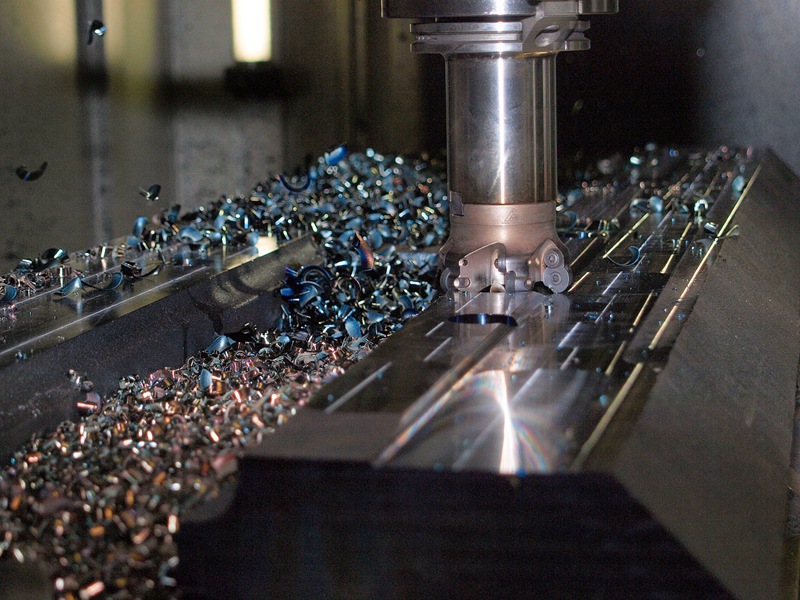Простые технологические соображения могут повысить производительность при фрезеровании титановых сплавов.
Титановые сплавы и алюминиевые сплавы схожи в следующих отношениях: Оба вида металлов используются для изготовления конструкционных элементов самолетов, и в обоих случаях, Компонент может потребовать 90 процент материала, который должен быть отфрезерован до того, как деталь будет завершена.
Многие магазины, вероятно, хотели бы, чтобы у этих металлов было больше общего, чем этот. Поставщики авиационной промышленности, которые комфортно обрабатывают алюминий, обнаруживают, что обрабатывают гораздо больше титана, потому что в новых конструкциях самолетов последний металл все чаще используется.

1. Держите радиальное зацепление на низком уровне
Одной из важнейших проблем титана является рассеивание тепла. В этом металле, Относительно небольшое количество тепла, выделяемого во время операции обработки, отводится вместе со стружкой. По сравнению с обработкой других металлов, Вместо этого больший процент тепла в процессе обработки титана поступает в инструмент. Из-за этого эффекта, Выбор радиального зацепления диктует выбор скорости поверхности в этом металле.
График на рисунке 1 показывает это. Полное прорезание пазов, то есть зацепление на 180 градусов, требует относительно низкой скорости поверхности. Но уменьшение радиального зацепления сокращает время, в течение которого режущая кромка выделяет тепло, и дает больше времени для охлаждения режущей кромки перед вводом материала при следующем вращении. Таким образом, так как радиальное зацепление уменьшается, Скорость обработки поверхности может быть увеличена при сохранении температуры в точке реза. Для отделки, процесс фрезерования, состоящий из очень маленькой дуги контакта с острым, Отточенная режущая кромка, высокая скорость обработки поверхности и минимальная подача на зуб позволяют добиться исключительных результатов.
2. Увеличить количество канавок
Обычно используемые концевые фрезы имеют четыре или шесть канавок. Из титана, Это может быть слишком мало. Более эффективным числом канавок может быть десять и более (см. Рисунок 2).
Увеличение количества канавок компенсирует потребность в низкой подаче на зуб. Малое расстояние между канавками инструмента с 10 зубьями слишком мало для зазора стружки во многих случаях. Однако, Производительное фрезерование титана уже благоприятствует малой радиальной глубине (Смотреть совет #1). Возникающая в результате этого мелкая стружка открывает возможности для использования концевой фрезы с большим количеством канавок для повышения производительности.
3. Сделайте толстый и тонкий чип
«Подъемное фрезерование» — привычный термин для этой идеи. То есть, Не подавайте фрезу так, чтобы кромка перемещалась по материалу в том же направлении, в котором подается инструмент. Известен как «обычное фрезерование»,«Такой подход к механической обработке приводит к тому, что стружка начинает тоньше и становится толще. При воздействии инструмента на материал, Силы трения создают тепло до того, как материал начинает отрываться от основного металла. Тонкая стружка не способна поглощать и отводить это выделяемое тепло, который вместо этого идет в режущий инструмент. Тогда, в точке выхода, где стружка толстая, Повышенное давление резания создает опасность для сцепления стружки.
Фрезерование методом подъема — или стружкообразование толщиной и тонкой — начинается с того, что режущая кромка входит в избыток материала и выходит на готовую поверхность (см. Рисунок 3). Боковое фрезерование, Инструмент пытается «перелезть» через материал, Создание толстой стружки на входе для максимального поглощения тепла и тонкой стружки на выходе для предотвращения прилипания стружки.
Фрезерование контурной поверхности требует тщательного изучения траектории инструмента, чтобы убедиться, что инструмент продолжает входить в излишки материала и таким образом выходить на обработанную поверхность. Добиться этого во время сложных проходов не всегда так просто, как просто держать материал справа.
4. Дуга в
В титане и других металлах, Срок службы инструмента теряется в моменты резкого изменения силы. Самый страшный из этих моментов часто наступает при попадании инструмента в материал. Непосредственная подача в поголовье (как и практически любая стандартная траектория движения инструмента) производит эффект, аналогичный удару молотком по режущей кромке.
Вместо этого скользите мягко. Для этого, Создание траектории инструмента, которая по дуге вдавливает инструмент в материал, а не вводит его по прямой линии (см. Рисунок 4). При фрезеровании толстым и тонким слоем, Дуга входа в траекторию должна следовать в том же направлении (по часовой стрелке или против часовой стрелки) по мере вращения инструмента. Траектория ввода дуги позволяет постепенно увеличивать силу резания, предотвращение выхватывания или нестабильности инструмента. Тепловыделение и стружка также увеличиваются постепенно, пока инструмент не будет полностью вовлечен в резание.
5. Конец на фаске
Резкие изменения силы могут произойти и на выходе из инструмента. Так же полезен, как и резка толстым к тонкому (кончик #3), Проблема с этим методом заключается в том, что толстое и тонкое образование внезапно прекращается, когда инструмент достигает конца прохода и начинает очищать металл. Резкое изменение приводит к такому же резкому изменению силы, удар током инструмента и, возможно, повреждение поверхности детали. Чтобы переход не был таким внезапным, Примите меры предосторожности и сначала фрезеруйте фаску под углом 45 градусов в конце прохода, чтобы инструмент видел постепенное снижение радиальной глубины резания (см. Рисунок 5).
6. Положитесь на вторичное облегчение
Острая режущая кромка минимизирует режущие силы при изготовлении титана, Но режущая кромка также должна быть достаточно прочной, чтобы противостоять давлению резания. Конструкция инструмента с вторичным рельефом, в котором первая положительная область режущей кромки противостоит силам, после чего вторая область отпадает для увеличения клиренса, достигает обеих этих целей (см. Рисунок 6). Вторичный рельеф распространен в оснастке, но в титане в частности, Эксперименты с инструментами с различными конструкциями вторичного рельефа могут привести к неожиданным изменениям в производительности резания или стойкости инструмента.
7. Изменение осевой глубины
На глубину реза, Окисление и химическая реакция могут повлиять на инструмент. Раннее повреждение может произойти в этом месте, если инструмент многократно используется на одной и той же глубине. При последовательных осевых резах, Этот поврежденный участок инструмента может привести к деформационному упрочнению, а также линии на детали, неприемлемые для аэрокосмических компонентов, Это означает, что такое воздействие на поверхность может потребовать ранней смены инструмента. Чтобы этого не допустить, Обезопасьте инструмент, изменяя осевую глубину резания для каждого прохода, распределение проблемной зоны по разным точкам вдоль канавки (см. Рисунок 7). В токарном деле, Аналогичного результата можно достичь, поворачивая конус на первом проходе и параллельно поворачивая на последующем проходе, предотвращение надрезов на глубине резания.
8. Ограничение осевой глубины вокруг тонких элементов
Коэффициент 8:1 полезно помнить при фрезеровании тонких стенок и неподдерживаемых элементов из титана. Во избежание прогиба стенок карманов, Фрезеруйте эти стенки в последовательных осевых ступенях вместо фрезерования на всю глубину стенки за один проход концевой фрезы. Конкретно, осевая глубина резания на каждой ступени вниз не должна быть больше 8 умноженная на толщину стены, которая останется после выполнения этих проходов фрезерования (см. Рисунок 8). Если стена 0.1 толщина дюйма, Например, осевая глубина резания для примыкающего к нему фрезерного прохода должна быть не более 0.8 дюйм.
Несмотря на ограничение по глубине, Можно работать по этому правилу так, что производительное фрезерование все еще возможно. Для этого, Обрабатывайте тонкие стенки так, чтобы вокруг стены оставался конверт из грубого материала, Создание функции 3 или 4 в разы толще итоговой функции. Если толщина стены составляет 0,3 дюйма, Например, Затем 8:1 правило допускает осевую глубину 2.4 дюйм. Следуя этим проходам, Используйте более легкую осевую глубину для обработки толстых стен до их конечного размера.
9. Выбирайте инструмент намного меньше карманного
Из-за степени, в которой инструмент поглощает тепло в титане, Инструмент должен иметь зазор для охлаждения. При фрезеровании маленького кармана, диаметр инструмента должен быть не более 70 процент от диаметра (или сопоставимый размер) кармана (см. Рисунок 9). Меньший зазор может привести к существенной изоляции инструмента от СОЖ, а также улавливать стружку, которая в противном случае могла бы унести хотя бы часть тепла.
Тем 70 Правило процента также может быть применено к фрезерованию инструмента по верхней части поверхности. В этом случае, Ширина объекта должна быть 70 процент от диаметра инструмента. Инструмент офсетный 10 процент для стимулирования создания толстой и тонкой стружки.
10. Возьмите пример с инструментальной стали
Станы с высокой подачей — инструментальная концепция, разработанная для обработки инструментальных сталей в производстве штампов/пресс-форм — в последние годы были адаптированы для обработки титана. Для стана с высокой отдачей требуется малая осевая глубина резания, но когда бежит на такую легкую глубину, Инструмент обеспечивает более высокую скорость подачи по сравнению с фрезами с более традиционными конструкциями.
Причина в истончении стружки. Ключом к мельнице с высокой подачей является пластина с большим радиусом изгиба режущей кромки (см. Рисунок 10). Этот радиус распределяет стружку по большой площади контакта на кромке. Из-за возникающего прореживания, Осевая глубина резания 0,040 дюйма может дать толщину стружки всего около 0.008 дюйм. Из титана, Эта тонкая стружка преодолевает низкую подачу на зуб, обычно требуемую для этого металла. Утончение стружки открывает путь к более высокой запрограммированной скорости подачи, чем это было бы возможно в противном случае.
 ИНСТРУМЕНТ С ЧПУ LOWIFAR
ИНСТРУМЕНТ С ЧПУ LOWIFAR